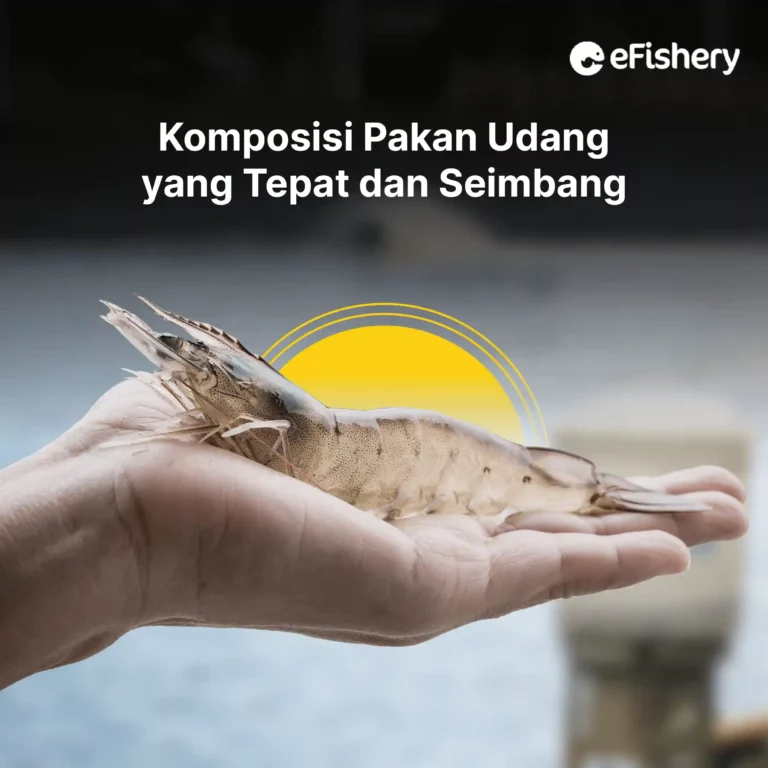Artikel Ini Telah Direview Oleh:

Laksono Radityo
Praktisi Budidaya Udang
The composition of the shrimp feed will determine the nutritional content of the feed for the shrimp. Thus, the composition of the feed must consist of ingredients that contain nutrients according to the needs of the shrimp. Check here to find out the nutritional needs of shrimp!
Shrimp Nutritional Needs
Shrimp feed is divided into 2 (two), namely manufactured feed and feed made independently. Factory-made feed is formulated according to the Indonesian National Standard (SNI) which contains nutrients according to the needs of shrimp, while feed that is made independently is formulated using ingredients that are easy to find and contain nutrients according to the needs of shrimp. The purpose of making feed independently is to reduce feed operational costs, but the nutritional needs of shrimp are still fulfilled.
Shrimp need nutrition to help improve the growth process and the immune system. The nutrients needed include protein, carbohydrates, fats, vitamins, and minerals. Here are the functions of each nutrient:
- proteins, It functions as a building agent, a regulatory agent, and an incendiary agent. The building blocks function to form new tissue for shrimp growth and repair tissue damage. Regulatory substances function to help metabolic processes, and fuel substances function as a source of energy when energy needs are not met by carbohydrates and fats.
- Carbohydrate, serves as an energy source.
- Fat, serves as a source of energy and as a solvent for some vitamins such as calcium and vitamin A.
- Vitamin, serves to regulate metabolic processes, influence the growth and formation of new cells, and help maintain the function of body tissues.
- Mineral, serves to assist the process of shell formation and maintain environmental balance.
According to SNI, the nutritional percentage of feed is divided into three groups based on feeding time (DOC) for shrimp, viz starter, grower And finisher. As for each of these phases has a different percentage of nutritional needs. Following are the nutritional requirements based on SNI that must be used for factory-made feed:
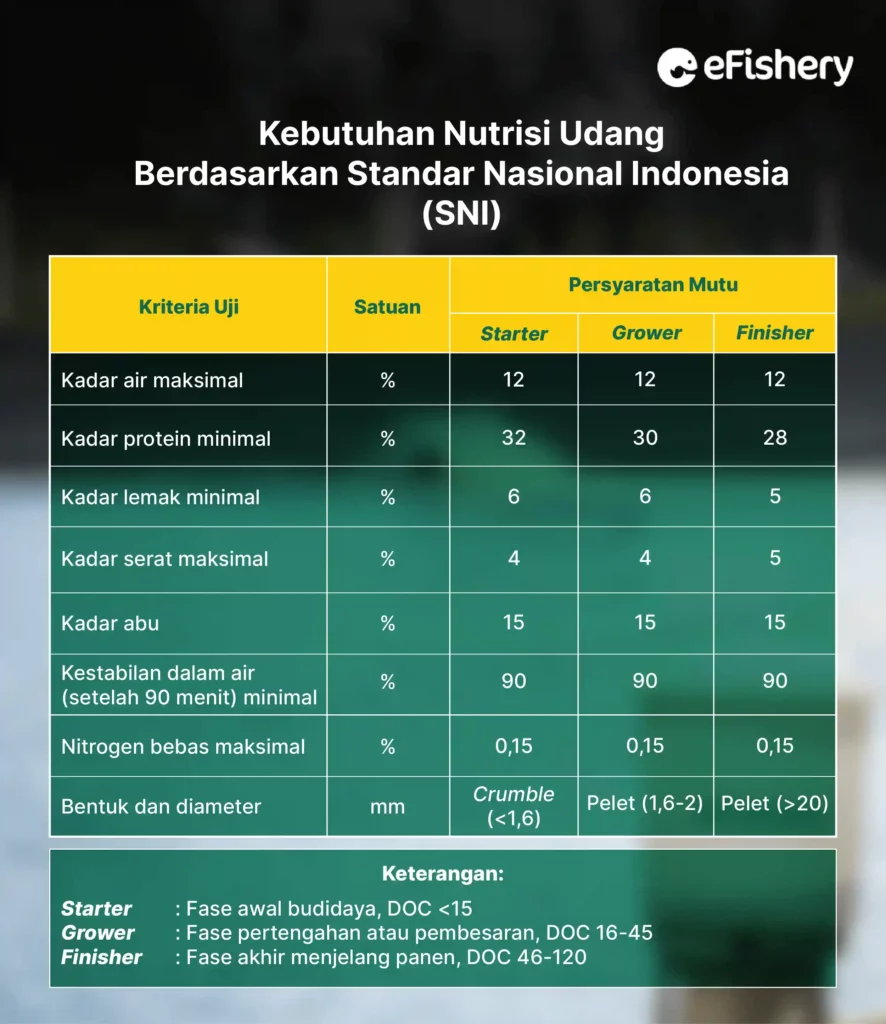
Shrimp Feed Raw Materials
Shrimp need balanced nutrition to optimize their growth. Feed nutrients such as protein, carbohydrates, fats, vitamins and minerals to make shrimp feed can be obtained from certain ingredients. For example, protein can be obtained from blood meal, fish meal, and others. The following are examples of ingredients that can be used to meet nutritional needs for making feed and their percentages:
1. Vegetable Raw Materials
Vegetable raw materials come from plants, such as wheat flour, sago flour, corn flour, and others. In general, vegetable raw materials are sources of carbohydrates, proteins and vitamins. The table below shows some examples of the types of vegetable raw materials that can be used for shrimp-made feed:
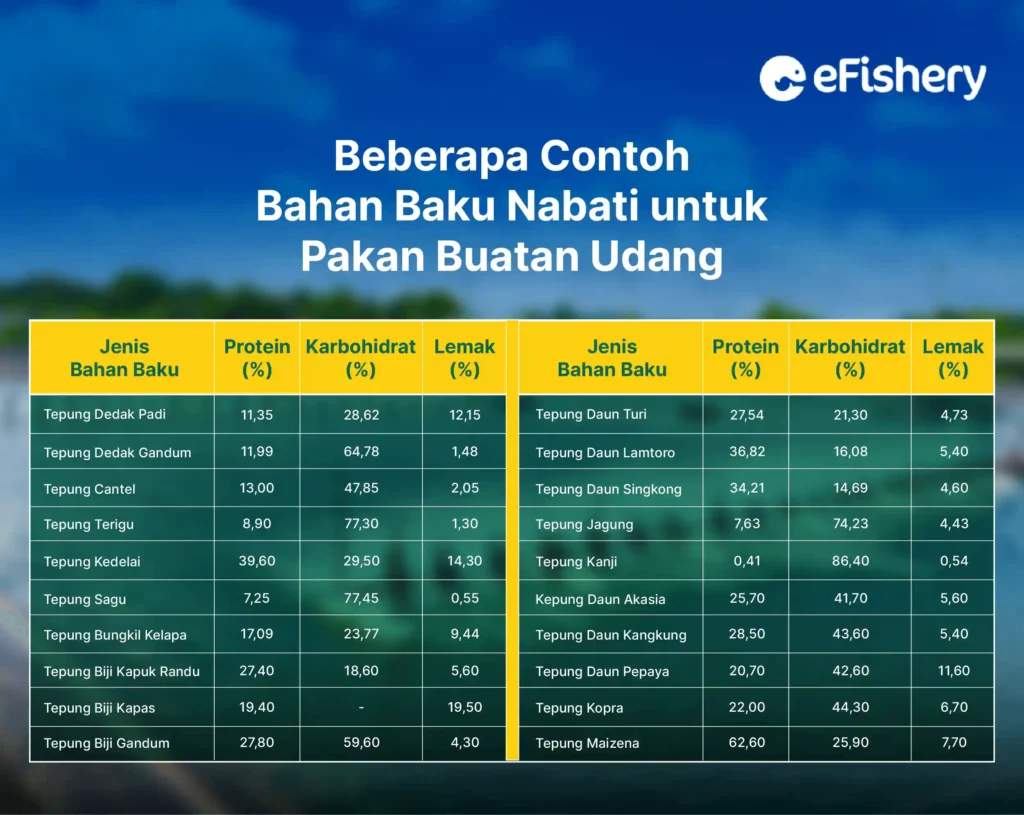
2. Animal Raw Materials
Animal raw materials come from land and water animals, such as chicken eggs, fish meal, crab flour, and others. In general, animal raw materials are sources of protein which are relatively easy to digest and tend to contain more complete amino acids than vegetable raw materials. Some examples of the types of animal raw materials that can be used for shrimp-made feed, namely:
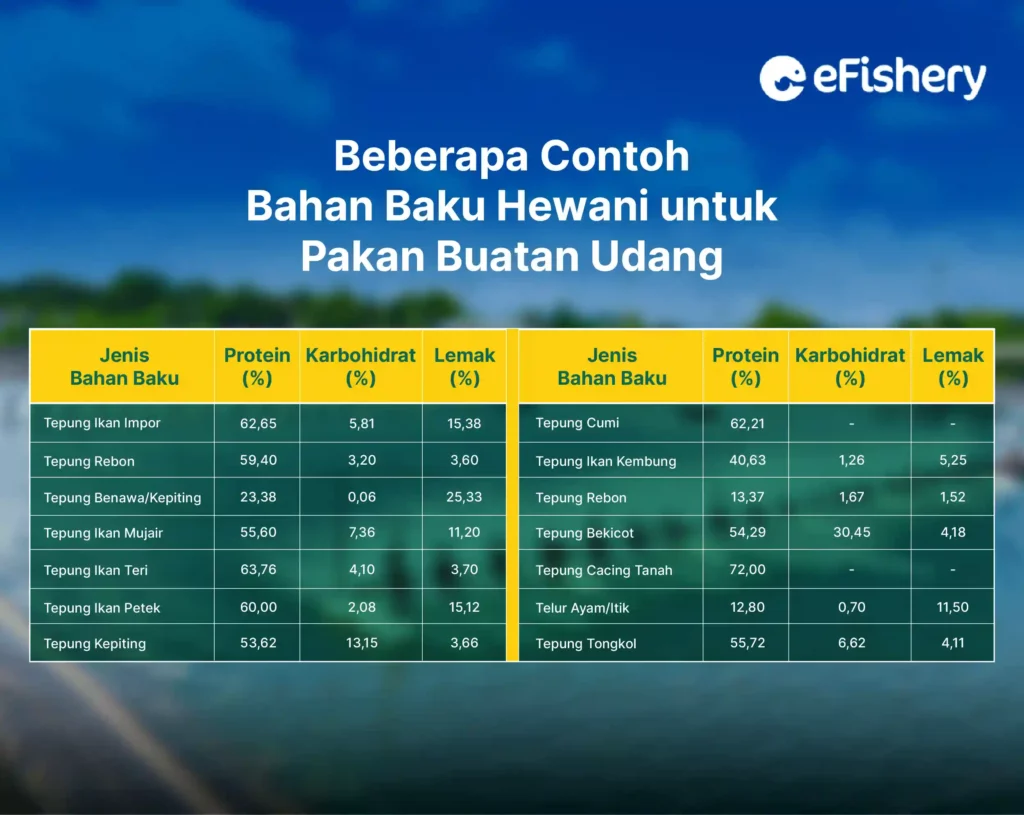
3. Agricultural Industry Waste Raw Materials
This raw material comes from agricultural waste, both vegetable and animal, such as tofu dregs, bran, shellfish flour, and others. Some examples of the types of agricultural waste raw materials that can be used for shrimp-made feed, namely:
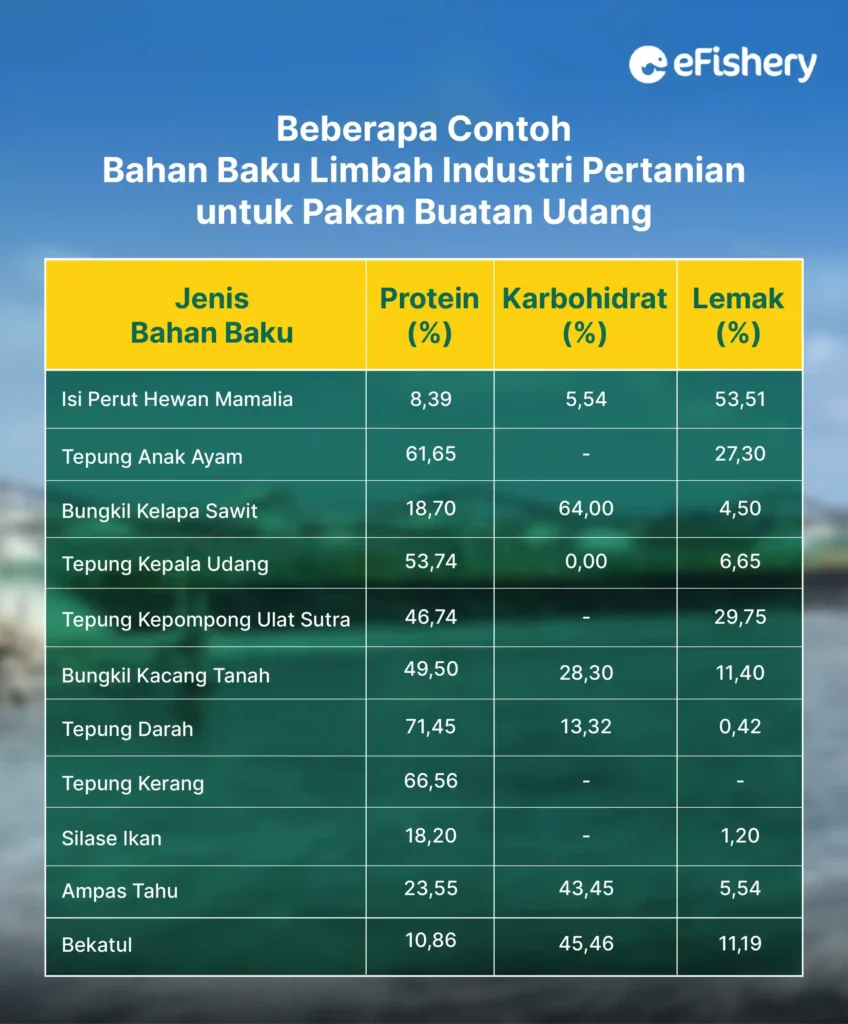
4. Other Raw Materials
Other raw materials that can be considered for making shrimp feed include gelatin, milk, and yeast. The following is the percentage of protein, carbohydrate and fat content of the three raw materials:
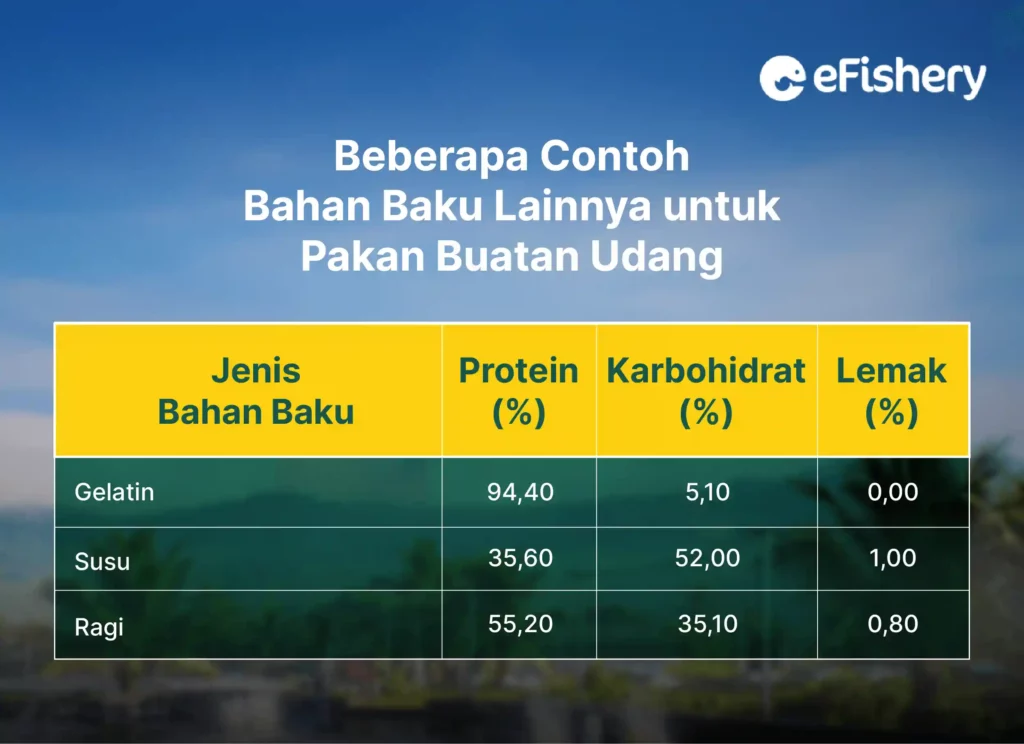
5. Additional Materials
These additives are complementary ingredients to nutritional needs, such as vitamins, minerals, antioxidants, and adhesives. In addition, additional ingredients are also usually used to stimulate appetite or add aroma to the feed, improve the texture of the feed, help improve metabolic processes and the digestive process of shrimp.
The selection of shrimp feed raw materials is determined by the amount of nutrients contained in it. Feed ingredients that are rich in protein and have good amino acids are usually more expensive. So, before choosing the raw materials used, you must know the nutritional content and the price of the ingredients used to meet the nutritional needs of the shrimp and prevent overruns in the cost of making feed.
The nutritional content of the feed must be adjusted to the shrimp growth phase because each phase has different nutritional needs. You must also pay attention to the composition and percentage of nutrients before buying or making your own feed because if the feed composition is not appropriate, it will cause adverse effects during the cultivation process.
Impact of Inappropriate Feed Composition
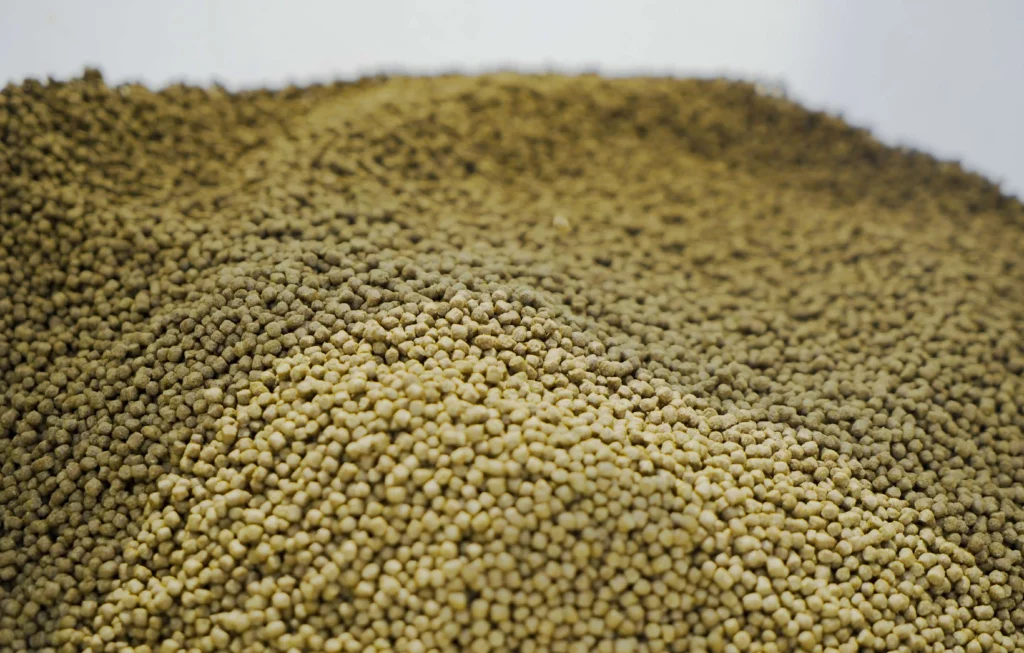
The impact of inappropriate feed composition is divided into 2 (two), nutritional deficiencies and excess nutrients.
Nutritional Deficiency
Lack of nutrition can inhibit the growth of shrimp, causing shrimp to grow slowly. Shrimp need adequate nutrition to optimize the existing systems in their bodies such as metabolism, formation of new tissues, molting, and others. When the nutrients needed are not enough, it will cause the system in the body not to work properly.
In addition, nutritional deficiencies can lead to increased feed costs because more and more feed is needed to meet the needs of the shrimp. Feed costs cost 60-70% of operational costs. When the feed has low or inappropriate composition and nutrients, you will only waste feed because the feed does not meet the nutritional needs for growing shrimp.
Excess Nutrition
Excess nutrition is also not good for the cultivation process, for example, such as excess protein. Protein is an important nutrient in shrimp feed which is needed to repair tissue damage and maintain routine body functions of shrimp. In addition, high protein in feed formulations can accelerate shrimp growth. However, protein that is too high will have an impact on high feed prices and has the potential to pollute the environment from shrimp feces and leftover feed. In addition, protein that is too high does not support the development of sustainable shrimp farming because the feed is only based on high protein without developing substitute nutrients to reduce the percentage of protein.
Carbohydrates that are too high are also not good for the cultivation environment. This is because carbohydrates that are too high will turn into organic waste (organic carbon). The more waste that is broken down by heterotrophic bacteria, the higher the consumption of oxygen by bacteria which will cause low dissolved oxygen.
Solutions for Shrimp to Get Balanced Nutrition
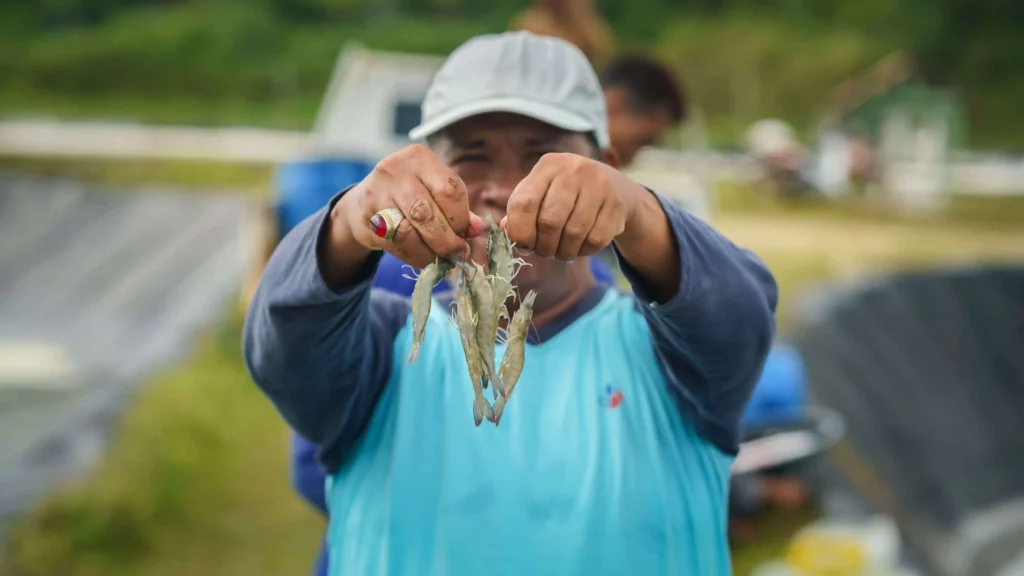
To get balanced nutrition, the following things can be done:
- Selection of feed ingredients. If you want to make feed independently, then you can choose ingredients that contain sufficient nutrients according to the needs of the shrimp, for example fish meal, bran flour, soy flour, corn flour, fish oil, and others.
- Increasing non-protein components such as fat and carbohydrates can be a strategy to minimize the use of protein feed. Protein is optimized only for growth, while energy needs are met from other sources, namely carbohydrates. Although the ability of shrimp to digest carbohydrates is indeed limited, their digestive ability can be improved by increasing the frequency of shrimp feeding.
- Research before buying. Each brand of feed has a different composition and nutritional content. So that you can find out in advance the composition and nutritional content of the feed for a particular brand before buying it so that the feed given to the shrimp can nourish the shrimp.
- Use feed additives or ingredients mixed into the feed. Feed additives has many benefits for shrimp, such as improving the quality of harvested shrimp, maintaining the quality of the feed used, and maintaining the quality of the pond environment.
- Feed management. Feed management is very necessary so that the feed given is in accordance with the needs of the shrimp. Feed management that can be done, such as the frequency of feeding, feeding according to age, the amount of feed given, selecting nutrients according to shrimp stadia, and others.
Need Help Regarding Shrimp Cultivation Business?
Fill in your personal data in the following form. Our team will immediately contact you via the number cellphone attached. Make sure the data entered is correct.
Learn More about Shrimp Feed Composition through Learning eFarm Cultivation
Fulfillment of shrimp nutrition is important because balanced nutrition can accelerate shrimp growth and optimize feed use. To adjust the composition of the feed according to the needs of the shrimp, you can do research on ingredients that have high nutrition and are easy to get or do nutritional checks on feeds that are sold in the market.
Material selection and nutritional checks are important before making or buying feed. If you want to learn more about shrimp feed, you can learn for free through the feature Learn Cultivation from the application eFarm.
eFarm is a pond management application to help facilitate Shrimp Farmers in carrying out their cultivation business. On application eFarm, there are features Learn Cultivation which is very useful for you. In this feature, there are explanatory videos about shrimp farming explained by aquaculture experts.
Interested in using eFarm? Downloads now and enjoy easy learning with Learn Cultivation in app eFarm!

Laksono Radityo - Praktisi Budidaya Udang
Berpengalaman sebagai asisten riset perikanan dan teknisi tambak udang. Saat ini aktif sebagai Technical Support Online di eFishery
Questions Regarding the Composition of Shrimp Feed
Nutrients needed by shrimp, in phase starter requires 32% protein, 6% fat, and 4% fiber. In phase grower requires 30% protein, 6% fat and 4% fiber. In phase finisher requires 28% protein, 5% fat, and 5% fiber
Shrimp feed is made from ingredients that have different nutrients. The ingredients for shrimp feed are fish meal, bran flour, soy flour, corn flour, fish oil, vitamins, minerals, and others.
- KKP. 2017. Technical Instructions for Making Cheap Feed with Simple Technology. Jepara Brackish Water Aquaculture Center (BBPBAP). 16 p
- Ritongga, L. BR., MA Sudrajat and MZ Arifin. 2021. Feed management for growing vannamei shrimp (Litopenaeus vannamei) in CV intensive ponds. Prosperous Numbers Together. 19(2): 197-197.
- Sary and Lisnawati. 2019. Information Book on Making Artificial Feed. Ministry of Education and Culture. 155 pp
- Indonesian National Standard (SNI) 7549-2009. Vaname Shrimp Feed Quality Requirements. National Standardization Agency. Jakarta.
- Zainuddin, Haryati and. S. Aslamsyah. 2016. Effect of various sources of feed carbohydrates on the growth and survival of the juvenile Litopenaeus vannamei vannamei shrimp. Agrocomplex. 16(1): 7-11
